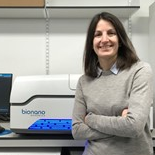Optical Genome Mapping in Human Neurogenetic Diagnostics: New Advances and Future Trends
A special issue of Biomolecules (ISSN 2218-273X). This special issue belongs to the section "Molecular Genetics".
Deadline for manuscript submissions: closed (30 June 2023) | Viewed by 7952
Special Issue Editor
Interests: sequencing; technologies; neurodevelopmental disorders; genetic epilepsies; next-generation sequencing; optical genome mapping; rare diseases
Special Issue Information
Dear Colleagues,
In recent years, optical genome mapping (OGM) has developed into a highly promising method of detecting large-scale structural variants in human genomes. It affords an effective technology for the detection of SVs, especially those that are mosaic, since these remain difficult to detect with current NGS technologies and with conventional chromosomal microarrays. It promises to be feasible as a first-line diagnostic tool, permitting insight into a new realm of previously unknown variants. However, due to its novelty, little experience with OGM is available to infer best practices for its application or to clarify which features cannot be detected.
The aim of this Special Issue would be to contribute to and expand the knowledge of applying OGM in genetically undiagnosed neurological patients, providing scientists with a useful collection of recent updates and advances in the field.
The aim of this Special Issue is to stimulate discussion around the use and adoption of OGM for clinical diagnostics in genetic neurological disorders, and more specifically to:
- Carry out an evaluation of OGM in different types of neurological disorders compared to conventional approaches or other novel technologies for structural and molecular classification;
- Introduce interpretative systems, software tools, or other bioinformatics approaches to improve data analysis and reporting in neurological disorders;
- Provide technical improvements or processes in neurological disease diagnosis using OGM to improve analysis, diagnostic sensitivity, etc.;
- Produce novel research findings that may lead to novel diagnostic insights in the future.
In this Special Issue, original research articles and reviews are welcome. Research areas may include (but are not limited to) the following:
- Repeat disorders;
- Genetic epilepsies;
- Neurodevelopmental disorders;
- Movement disorders.
Dr. Stephanie Efthymiou
Guest Editor
Manuscript Submission Information
Manuscripts should be submitted online at www.mdpi.com by registering and logging in to this website. Once you are registered, click here to go to the submission form. Manuscripts can be submitted until the deadline. All submissions that pass pre-check are peer-reviewed. Accepted papers will be published continuously in the journal (as soon as accepted) and will be listed together on the special issue website. Research articles, review articles as well as short communications are invited. For planned papers, a title and short abstract (about 100 words) can be sent to the Editorial Office for announcement on this website.
Submitted manuscripts should not have been published previously, nor be under consideration for publication elsewhere (except conference proceedings papers). All manuscripts are thoroughly refereed through a single-blind peer-review process. A guide for authors and other relevant information for submission of manuscripts is available on the Instructions for Authors page. Biomolecules is an international peer-reviewed open access monthly journal published by MDPI.
Please visit the Instructions for Authors page before submitting a manuscript. The Article Processing Charge (APC) for publication in this open access journal is 2700 CHF (Swiss Francs). Submitted papers should be well formatted and use good English. Authors may use MDPI's English editing service prior to publication or during author revisions.
Keywords
- structural variation
- optical genome mapping
- neurodevelopmental disorders
- repeat disorders






